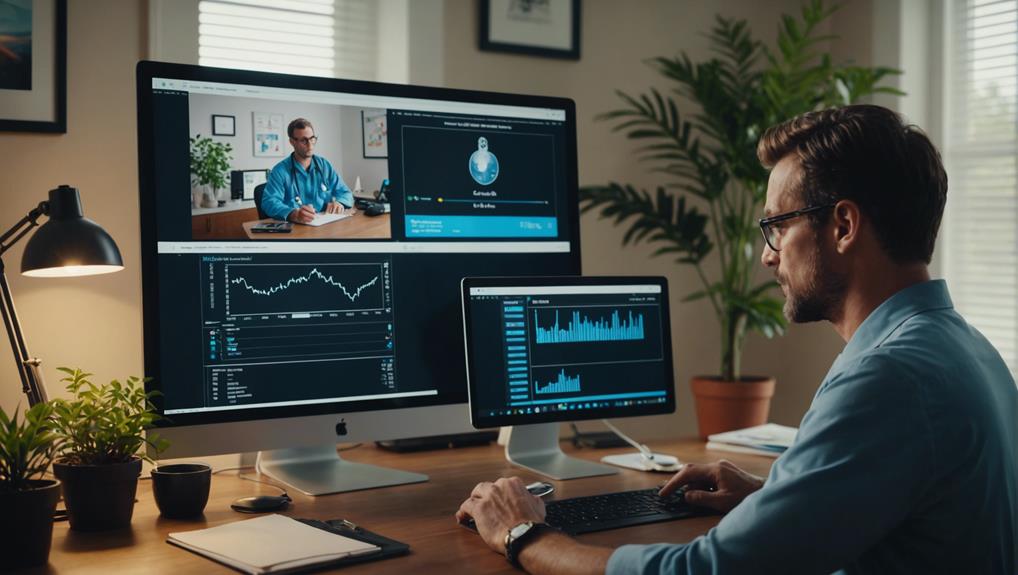Remote Work for Healthcare Professionals: Telemedicine, Medical Writing, Etc
Remote work for healthcare professionals, like telemedicine and medical writing, presents a modern way to connect with patients and contribute to healthcare. The evolution of telehealth technology has led to improved patient outreach and flexibility in healthcare roles. While remote medical writing offers its own set of advantages, challenges exist in providing patient care from a distance. Embracing tools for remote health monitoring and receiving proper training are essential for success. As you explore these opportunities further, you'll uncover upcoming trends in telehealth and important considerations for remote care provision.
The Rise of Telemedicine
Telemedicine has revolutionized the healthcare industry by allowing healthcare professionals to provide remote care to patients using technology. The adoption of telemedicine has notably increased in recent years, offering numerous benefits to both healthcare providers and patients.
One of the key advantages of telemedicine is the ability to conduct remote consultations, enabling patients to receive medical advice and treatment without the need for in-person visits. This not only saves time for patients but also reduces the burden on healthcare facilities.
Remote consultations through telemedicine also improve access to healthcare services, particularly for individuals in rural or underserved areas. Patients can connect with healthcare professionals from the comfort of their own homes, eliminating the need for long-distance travel.
Additionally, telemedicine allows for quicker diagnosis and treatment, leading to better health outcomes for patients. Overall, the rise of telemedicine and the increasing adoption of remote consultation services are transforming the way healthcare is delivered, making it more convenient and efficient for both patients and providers alike.
Benefits of Remote Medical Writing
Remote medical writing offers healthcare professionals the opportunity to efficiently create and disseminate critical medical content from a distance, enhancing productivity and collaboration in the field. Through remote collaboration, medical writers can seamlessly work with healthcare teams, researchers, and other professionals regardless of geographical barriers. This fosters a more inclusive and diverse approach to medical content creation, bringing together experts from around the world to contribute their unique insights.
When engaging in remote medical writing, utilizing effective writing strategies becomes essential. Clear communication, concise language, and adherence to industry-specific guidelines are vital for producing high-quality medical content. Remote medical writers must also be adept at organizing information logically, synthesizing complex data, and tailoring their writing to suit the target audience, whether it be healthcare professionals, patients, or regulatory bodies.
Telehealth Technology Advancements
Advancements in telehealth technology have revolutionized the way healthcare professionals connect with patients and deliver care, improving access and efficiency in the healthcare industry. Remote consultations have become increasingly common, allowing healthcare providers to interact with patients in real-time from different locations. This technology enables healthcare professionals to offer timely medical advice, monitor patients' conditions, and provide follow-up care without the need for in-person visits.
Virtual diagnostics have also seen significant improvements, with healthcare professionals now being able to conduct remote examinations and assessments using high-quality audio and video tools. Through virtual diagnostics, patients can receive preliminary evaluations and recommendations from the comfort of their homes, reducing the need for unnecessary trips to healthcare facilities.
Flexibility in Healthcare Roles
With the evolving landscape of healthcare, professionals are increasingly embracing flexible roles to adapt to changing patient needs and industry demands. This shift towards flexibility in healthcare roles allows for improved work-life balance and greater opportunities for career growth. By having the ability to work remotely or on flexible schedules, healthcare professionals can better manage their personal responsibilities while still delivering quality care to patients.
Achieving a better work-life balance is essential for overall well-being and job satisfaction. Flexible healthcare roles enable professionals to allocate time for personal pursuits, family obligations, and self-care, leading to reduced burnout and increased job fulfillment.
Additionally, the flexibility in healthcare roles opens up avenues for career growth. Professionals can explore different specialties, take on new responsibilities, or pursue further education while maintaining a balanced lifestyle.
Challenges of Remote Patient Care
As you navigate remote patient care, you may encounter challenges related to patient data security and technology access.
It's essential to guarantee that sensitive patient information remains protected while utilizing remote platforms.
Additionally, addressing any technology barriers that patients face can help maintain effective communication and care delivery.
Patient Data Security
Ensuring patient data security remains an essential challenge in the field of remote patient care for healthcare professionals. Data encryption and cybersecurity measures are paramount in safeguarding sensitive patient information when conducting remote consultations or managing electronic health records.
Implementing robust encryption protocols helps protect data both in transit and at rest, ensuring that only authorized individuals can access patient records.
Cybersecurity measures such as multi-factor authentication, secure video conferencing platforms, and regular security audits are vital components of a thorough patient data protection strategy. Healthcare professionals must stay vigilant against potential cyber threats, including phishing attacks and ransomware, which can compromise patient privacy and confidentiality.
Collaboration between healthcare providers, IT professionals, and cybersecurity experts is essential in developing and implementing effective data security protocols. By prioritizing patient data security and staying informed about the latest cybersecurity trends and best practices, healthcare professionals can confidently navigate the challenges of remote patient care while upholding the trust and integrity of the healthcare profession.
Technology Access Issues
To effectively address the challenges of remote patient care, healthcare professionals must confront the technology access issues that can hinder the seamless delivery of healthcare services.
One important aspect is ensuring adequate technology training for healthcare staff to effectively utilize remote connectivity tools. Without proper training, healthcare professionals may struggle to navigate telemedicine platforms, electronic health records systems, or other technology essential for remote patient care.
Remote connectivity plays a significant role in facilitating virtual consultations, monitoring patient vitals remotely, and sharing crucial medical information securely. However, issues such as poor internet connectivity or outdated devices can disrupt this connectivity, impacting the quality of care provided to patients.
Healthcare professionals need to have reliable access to high-speed internet and up-to-date devices to ensure seamless communication and data transmission during remote patient consultations.
Impact on Healthcare Accessibility
When you consider the impact of remote work for healthcare professionals on healthcare accessibility, key points emerge.
Remote work enables better access to healthcare in rural areas, bridging the gap between patients and providers.
This can play a pivotal role in addressing health disparities and enhancing patient outreach efforts.
Access to Rural Areas
Improving healthcare accessibility in rural areas through remote work for healthcare professionals can greatly bridge the gap in services for underserved populations. Rural connectivity challenges have historically hindered access to quality healthcare in remote areas. However, the impact of remote healthcare services is notably transforming the landscape of rural healthcare.
By leveraging telemedicine and other remote work opportunities, healthcare professionals can now reach patients in rural areas more efficiently than ever before. Remote healthcare has the potential to provide immediate access to medical expertise, diagnostic services, and treatment options for individuals living in remote regions. This not only improves the quality of care but also reduces the barriers posed by geographical distance.
Additionally, remote work allows healthcare professionals to collaborate seamlessly with local healthcare providers, enhancing the overall standard of care in rural communities.
Health Disparities Addressed
Addressing health disparities through remote work for healthcare professionals involves leveraging technology to guarantee equitable access to quality healthcare services for underserved populations. Health equity is at the forefront of remote solutions, allowing healthcare professionals to reach individuals who may face barriers to traditional in-person care.
One significant aspect of this is the diversity in telemedicine, which enables patients from various backgrounds to receive culturally competent care.
Remote work offers opportunities to bridge the gap in healthcare access by providing services to those in rural or urban areas with limited resources. By utilizing telemedicine, healthcare professionals can connect with patients regardless of their geographical location, socioeconomic status, or physical abilities. This approach not only enhances convenience for patients but also promotes inclusivity in healthcare delivery.
Moreover, remote solutions enable healthcare providers to offer specialized care to marginalized communities, addressing disparities in healthcare outcomes. Through telemedicine, individuals who may have previously struggled to access healthcare services can now receive the attention they need, ultimately contributing to a more equitable healthcare system.
Improved Patient Outreach
Improving patient outreach through remote work initiatives greatly impacts healthcare accessibility by expanding reach and enhancing healthcare delivery efficiency. Patient engagement is fundamental in ensuring that individuals receive the care they need, and remote consultations provide a convenient way for healthcare professionals to connect with patients regardless of their location.
Virtual support platforms enable continuous communication and monitoring, fostering stronger patient-provider relationships and empowering individuals to take charge of their health.
Community outreach programs facilitated through remote work allow healthcare professionals to reach underserved populations, improving access to care for those who may face barriers to traditional healthcare services. By leveraging technology to bridge the gap between patients and providers, healthcare accessibility is enhanced, leading to better health outcomes and increased patient satisfaction.
Embracing remote work in patient outreach not only benefits individuals in need of care but also strengthens the healthcare system as a whole by promoting inclusivity and efficiency.
Remote Health Monitoring Tools
Remote health monitoring tools play a crucial role in enabling healthcare professionals to track and assess patient health data from a distance. Through remote essential monitoring, healthcare providers can remotely monitor important health metrics such as heart rate, blood pressure, and blood glucose levels in real-time. This capability allows for timely interventions and adjustments to treatment plans without the need for in-person visits.
Wearable technology integration further enhances remote health monitoring by enabling patients to collect and transmit their health data seamlessly. Devices like smartwatches, fitness trackers, and other wearable sensors can continuously track various health parameters and transmit the information to healthcare professionals.
This integration not only provides a continuous stream of data but also promotes patient engagement and awareness of their own health status.
Training for Remote Healthcare Providers
To effectively utilize remote health monitoring tools, healthcare professionals must undergo specialized training to adapt their skills and workflows to the virtual care environment. Remote training options are essential for healthcare providers shifting to remote work settings. These options often include webinars, online courses, and virtual workshops that cover topics like telehealth best practices, data security protocols, and effective communication in virtual consultations.
In addition to theoretical training, practical experience is crucial. Virtual simulation exercises offer a hands-on approach to honing remote healthcare skills. These exercises simulate real-life scenarios where providers interact with virtual patients, practice making diagnoses, and learn how to use remote monitoring devices effectively.
Future Trends in Telehealth
As telehealth continues to evolve, emerging trends are reshaping the future landscape of remote healthcare delivery. Virtual consultations are becoming increasingly popular as healthcare providers and patients alike recognize the convenience and accessibility they offer. Through virtual consultations, healthcare professionals can connect with patients remotely, providing diagnosis, treatment plans, and ongoing care without the need for in-person visits.
Digital healthcare trends are also driving the future of telehealth. Technologies such as wearable devices, remote monitoring systems, and artificial intelligence are revolutionizing how healthcare is delivered at a distance. Wearable devices can collect real-time health data, allowing for more proactive and personalized care. Remote monitoring systems enable healthcare providers to track patients' progress remotely, enhancing continuity of care. Artificial intelligence is being used to analyze vast amounts of healthcare data quickly and accurately, aiding in diagnosis and treatment decisions.
These advances in virtual consultations and digital healthcare trends are paving the way for a more efficient, accessible, and patient-centered remote healthcare experience.
Regulatory Considerations for Remote Care
Let's address the essential aspects of regulatory considerations for remote care:
Legal compliance guidelines,
telehealth licensing requirements, and
privacy and security measures.
Understanding these points is vital to guarantee that your remote healthcare practices adhere to the necessary regulations and standards.
Legal Compliance Guidelines
Compliance with legal regulations is an essential aspect to take into account when providing remote care as a healthcare professional. To guarantee adherence to these regulations, thorough compliance training is vital. This training equips you with the knowledge and skills needed to navigate the intricacies of legal requirements when delivering care remotely.
Legal documentation also plays a pivotal role in maintaining compliance. Proper documentation not only serves as a record of the care provided but also ensures that all legal aspects are met. This includes obtaining informed consent from patients, securely storing medical records, and following data protection regulations.
Telehealth Licensing Requirements
Understanding telehealth licensing requirements is a crucial aspect of providing remote care as a healthcare professional. Telehealth licensing guarantees that you comply with the necessary regulations to practice medicine virtually.
Each state has its own set of telemedicine regulations that dictate the licensure requirements for healthcare providers offering services remotely. It's essential to familiarize yourself with these regulations to avoid any legal issues and provide safe and effective care to your patients.
When considering telehealth licensing, you must determine if you need to obtain a specific license to practice telemedicine in the state where your patient is located. Some states require healthcare professionals to hold a license in the state where the patient receives the telehealth services, while others offer special telemedicine licenses.
Additionally, understanding the telehealth licensing requirements can help you navigate the complexities of practicing across state lines and ensure that you're meeting all necessary legal obligations. Stay informed about the latest telehealth licensing regulations to streamline your remote practice and deliver exceptional care to your patients.
Privacy and Security
Maintain stringent privacy and security measures to adhere to regulatory standards when providing remote care as a healthcare professional. Data encryption plays a critical role in safeguarding sensitive patient information during telemedicine consultations. Encrypting data ensures that only authorized individuals can access and interpret the information, reducing the risk of unauthorized data breaches.
Additionally, healthcare professionals must guarantee HIPAA compliance when handling patient data remotely. Adhering to HIPAA regulations helps protect patient privacy and confidentiality, establishing trust between healthcare providers and patients in virtual care settings.
Implementing robust security protocols, such as secure video conferencing platforms and encrypted messaging systems, is essential in upholding patient confidentiality. Regularly updating software and systems that handle patient data can further enhance security measures.
Conducting risk assessments and staying informed about evolving cybersecurity threats are crucial steps in maintaining a secure remote care environment. By prioritizing data encryption and HIPAA compliance, healthcare professionals can deliver remote care services effectively while safeguarding patient privacy.
Conclusion
To sum up, the future of remote work for healthcare professionals is bright, with telemedicine and medical writing leading the way. With advancements in telehealth technology and increased flexibility in healthcare roles, the possibilities are endless.
However, challenges such as remote patient care and regulatory considerations must be addressed. As the industry continues to evolve, healthcare providers must adapt and embrace the changes to provide the best possible care for patients.
The future of telehealth is truly promising.







